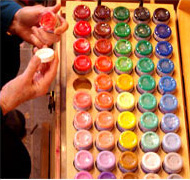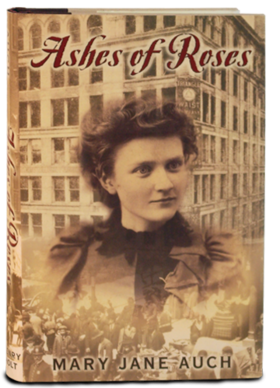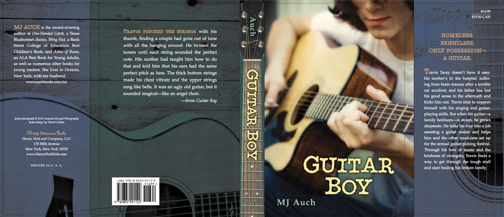
After Travis Tacey’s mother is hospitalized from a serious accident, his grief-stricken father throws him out. Travis has to find a way to survive with nothing but a few dollars, a change of clothes, and his great-great-great grandfather's guitar. Here is how some events in my life became the catalyst for this novel.
 I’ve had a passion for guitars ever since I started playing one in graduate school. I still have my original guitar -- an old Guild Mark I, which has great sound, but it had become harder for me to play over the years because of its size. Then I met luthier Bernie Lehmann whose custom-made guitars were works of art. Bernie told me he could make a guitar to allow me to play comfortably. Because Bernie’s workshop is in nearby Rochester NY, I was able to watch my guitar grow from a few thin slabs of wood into an instrument that almost seems to live and breathe. Bernie has a passion for building instruments, making the whole process a pleasure to behold.
I’ve had a passion for guitars ever since I started playing one in graduate school. I still have my original guitar -- an old Guild Mark I, which has great sound, but it had become harder for me to play over the years because of its size. Then I met luthier Bernie Lehmann whose custom-made guitars were works of art. Bernie told me he could make a guitar to allow me to play comfortably. Because Bernie’s workshop is in nearby Rochester NY, I was able to watch my guitar grow from a few thin slabs of wood into an instrument that almost seems to live and breathe. Bernie has a passion for building instruments, making the whole process a pleasure to behold.
Some of the building steps seemed almost magical. We chose the wood for the top of the guitar by tapping it to hear its tone. One piece of Adirondack Spruce produced a low, ringing sound that made us both gasp. That would become the top for my new guitar.

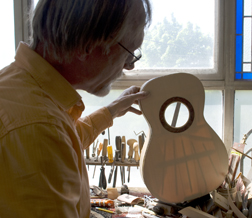 Bernie worked on the painstaking process of thicknessing the top, and carving and placing the braces. The next time I saw the guitar, the top was so thin, you could see sunlight through it. That would allow the top to resonate, producing a full, rich tone.
Bernie worked on the painstaking process of thicknessing the top, and carving and placing the braces. The next time I saw the guitar, the top was so thin, you could see sunlight through it. That would allow the top to resonate, producing a full, rich tone.
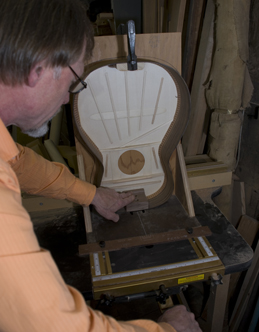
The more trips I made to Bernie’s workshop, the more fascinated I became. I saw him bend guitar’s sides over a pipe heated by a torch, transforming a stiff piece of rosewood into graceful curves. Another day I watched him shape the edges with a small plane, peeling off curls of rosewood that filled the room with a sweet, spicy fragrance. I can still smell that rosewood as I play the guitar.
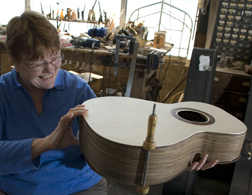 Finally the top, sides and back were joined and clamped, so I could hold the body of my guitar, minus the neck.
Finally the top, sides and back were joined and clamped, so I could hold the body of my guitar, minus the neck.

 The binding went on next – a thin strip of pernambuco carefully placed around the top edge.
The binding went on next – a thin strip of pernambuco carefully placed around the top edge.
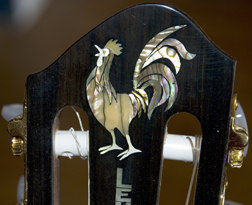
Knowing that I was an illustrator, Bernie suggested that I design something for the headstock. I drew this rooster, and watched Bernie cut it out of abalone and fit it into precisely carved openings in the ebony headstock.
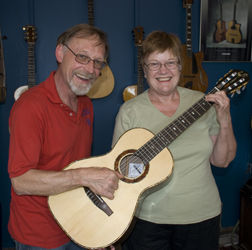 Finally one day, I got the call that the guitar was finished. I arrived in time to see Bernie tune it up and play. It sounded as beautiful as it looked.
Finally one day, I got the call that the guitar was finished. I arrived in time to see Bernie tune it up and play. It sounded as beautiful as it looked.
I was so excited by the guitar-building process, I wanted to write a book about it. When I approached my editor, Christy Ottaviano, with a proposal for a nonfiction project, she said she’d rather see me write a novel that featured a luthier as one of the characters.
I was disappointed at first, but then another guitar-related event came to mind, and the first strands of Guitar Boy started to intertwine. Years ago, when I worked as an Occupational Therapist, a college student with a traumatic head injury was admitted to our hospital for intensive rehabilitation. He had been reduced to the level of an infant, unable to speak, or even swallow. His limitations were so severe, the Physical Therapist, Speech Therapist, and I often worked with him simultaneously. He gradually recovered the ability to swallow and eat, but still had no speech.
Then one day his father told us that his son had been a big fan of folk music. One of the residents also played the guitar, so we started bringing the boy into the OT room at the end of every afternoon for a folk song session. He obviously enjoyed the music, clapping his hands to the rhythm, but he made no attempt to sing. Then one day we played If I Had a Hammer, and his voice rang out loud and clear. It took our breath away.
Now I had the two key pieces to start writing Guitar Boy. Soon I saw and heard snippets of 14-year-old Travis Tacey, and began to gather a family around him – his older sister, June, and the younger kids, Roy, Earleen, and Lester – all named after guitar players. I love this part of writing a book, where wispy ideas start coming to me and I try to fit them together like puzzle pieces.
I decided that the character with the traumatic head injury should be Travis’s mother, Geneva, and that her accident would occur before the book started. Then I brought the family onstage as they visited her in the hospital for the first time. From there, it was a matter of putting myself into the heads of the characters, learning what made them tick.
I had Travis meet luthier Scott McKissack. And when he did, I got to have Travis be as fascinated seeing Scott build a guitar as I was when watching Bernie Lehmann build mine.
What followed was the joy of working on the book with Christy Ottaviano – our sixth to date.
And she was right. It was meant to be a novel.
 Mary Jane Auch on
Mary Jane Auch on  Friday, June 26, 2015 at 9:38AM
Friday, June 26, 2015 at 9:38AM  Herm and I have enjoyed getting to know chicken author, Henrietta Fowler over the course of her first two adventures — SOUPERCHICKEN, where she teaches herself to read, and THE PLOT CHICKENS, where she studies to become a writer.
Herm and I have enjoyed getting to know chicken author, Henrietta Fowler over the course of her first two adventures — SOUPERCHICKEN, where she teaches herself to read, and THE PLOT CHICKENS, where she studies to become a writer. 
